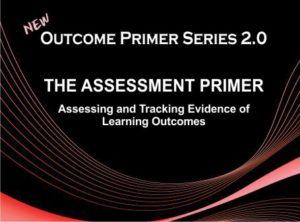The ASSESSMENT Primer: Assessing and Tracking Evidence of Learning Outcomes
By: Ruth Stiehl and Lynn Null
| PREFACE: The OUTCOME Primers Series 2.0 | |||||||||||
| Once a Fad – Now a Fact | xv | ||||||||||
| Distinguishing Our Work | xvi | ||||||||||
| PART ONE: Re-envisioning Learning and Assessment | |||||||||||
| The sea is around us, but the river is in us. | |||||||||||
| Introduction: Using the River to Think About Assessment | 3 | ||||||||||
| The Key to Assessing Learning Outcomes | 15 | ||||||||||
| Work Quality Assessment – What is It?. | 17 | ||||||||||
| -Distinguishing Characteristics of Work Quality Assessment | 19 | ||||||||||
| -Distinguishing Characteristics of Knowledge Testing | 21 | ||||||||||
| Creating the Rapids: Role-related Assessment Tasks | 22 | ||||||||||
| Adding Assessment Tasks to an Outcome Guide | 25 | ||||||||||
| PART TWO: The Purpose and Use of Learning Evidence | |||||||||||
| There are three very different reasons for assessing learning outcomes:to ASSIST the learner, to ADVANCE the learner and to ADJUST our own shortcomings; each requires a different set of tools. | |||||||||||
| Knowing Why We Assess Learning . | 33 | ||||||||||
| -Assessing to ASSIST | 33 | ||||||||||
| -Assessing to ADVANCE . | 35 | ||||||||||
| -Assessing to ADJUST (closing the loop) | 36 | ||||||||||
| Knowing What to Assess | 38 | ||||||||||
| -Assessing the Content (water) . | 38 | ||||||||||
| -Assessing the Learners (paddlers) | 39 | ||||||||||
| -Assessing the Experience (journey) | 41 | ||||||||||
| PART THREE: Defining What’s Good | |||||||||||
| The key to work quality assessment is our ability to first define “what’s good;” “what’s good” should never be a secret. | |||||||||||
| Defining What’s Good | 45 | ||||||||||
| Who Decides “What’s Good?” | 46 | ||||||||||
| -Professional Judgment | 46 | ||||||||||
| -Social Construction | 47 | ||||||||||
| -Learner Perception. | 48 | ||||||||||
| Prototyping Assessment Criteria | 49 | ||||||||||
| -Finding the Right Sources | 49 | ||||||||||
| -Gathering the Input. | 50 | ||||||||||
| Prototyping Assessment Criteria at the Course or Workshop Level: A Facilitator’s Guide . | 51 | ||||||||||
| Prototyping Assessment Criteria at the Program Level: A Facilitator’s Guide . | 54 | ||||||||||
| PART FOUR: Creating Assessment Tools | |||||||||||
| Scoring Guides, Checklists, and Rubrics—it’s all about creating the right tool for the right purpose. | |||||||||||
| Introduction | 61 | ||||||||||
| Creating Tools to Assist (formative assessment) | 61 | ||||||||||
| -The Scoring Guide | 62 | ||||||||||
| -The Checklist | 68 | ||||||||||
| -Putting it Together | 72 | ||||||||||
| Creating Tools to Advance (summative assessment) | 72 | ||||||||||
| -The Rubric | 73 | ||||||||||
| -Scales and Marks | 83 | ||||||||||
| Creating Tools to Adjust | 83 | ||||||||||
| -Learner Satisfaction Tool | 84 | ||||||||||
| -Structured Exit Interview Tool | 84 | ||||||||||
| -Learner Assessment of Instructor’s Performance | 87 | ||||||||||
| -Instructor’s Self-reflection and Assessment Checklist | 87 | ||||||||||
| PART FIVE: Tracking and Displaying Evidence | |||||||||||
| An obvious fact about the joining of two rivers is that it changes them both. No river that joins another remains unaltered.—Rebecca Lawton in Reading Water: Lessons from the River | |||||||||||
| Making the Case for Displaying Evidence | 95 | ||||||||||
| Differentiating Direct and Indirect Evidence | 96 | ||||||||||
| Understanding the Confluence of Learning Evidence | 97 | ||||||||||
| -Tracking and Displaying Direct Learning Evidence | 100 | ||||||||||
| -Tracking and Displaying Indirect Learning Evidence | 105 | ||||||||||
| -Using Evidence to Adjust the Learning Experience | 111 | ||||||||||
| PART SIX: Using Learning Evidence | |||||||||||
| Eddy: A place in the river where the current runs contrary to the main stream — an opportunity where the river is calm and the time is to reflect. | |||||||||||
| Assisting Learners: A Minor Eddy | 125 | ||||||||||
| Advancing Learners: A Major Eddy | 126 | ||||||||||
| Adjusting Our Practices: Both Minor and Major Eddies | 127 | ||||||||||
| PART SEVEN: Continuing Your Learning | |||||||||||
| In Conclusion | 133 | ||||||||||
| Next Steps | 133 | ||||||||||
| Appendix A: Assessment Tools |
|||||||||||
| Outcome Guides | |||||||||||
| Program Outcome Guide: Gerontology Community Education Certification Program | 138 | ||||||||||
| Workshop Outcome Guide: Workshop for Adult Aging Traffic Offenders | 139 | ||||||||||
| Scoring Guides | |||||||||||
| Scoring Guide: Assessing Your Ability to Work Independently | 140 | ||||||||||
| Scoring Guide: Communicates Effectively | 141 | ||||||||||
| Rubrics | |||||||||||
| Rubric: Oral Presentation | 144 | ||||||||||
| Rubric: Online Discussion | 147 | ||||||||||
| Rubric: Research Application | 148 | ||||||||||
| Rubric: AEP 212, Alternative Energy Systems | 149 | ||||||||||
| Appendix B: Our Preferred Terms for Assessing and Tracking Evidence of Learning Outcomes |
151 | ||||||||||
| Related Readings | 153 | ||||||||||
| Acknowledgments | 159 | ||||||||||
| About the Authors | 160 | ||||||||||


